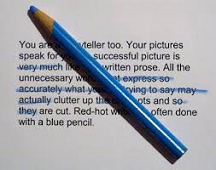Editors make writing better by taking out words

How often do you hear someone from your book group say, “I liked the novel, but it could have used some editing”? Or read a review of a 500-page tome and have the reviewer say, “It could have been a couple of hundred pages shorter”?
One of the casualties of consolidation in the publishing world and cutting editorial budgets to the bone is that less editing is getting done. This applies not only to nonfiction, where content usually trumps style, but also to fiction. There are plenty of novels that could benefit from some nip and tuck or even wholesale cuts.
Editing takes place on two or three levels. There is the book editor — who may be the acquisition editor but often is not — who helps the writer shape the overall content. This can be a consultative process as the writer submits the work in installments. The editor may say it simply needs to be shorter. Even more helpful is if he or she can recommend specific content that can be compressed or cut altogether.
There may also be a line editor, who goes through line by line with a pencil, discarding paragraphs or pages, cutting sentences in half, moving text around, asking for clarification or additional material. And, finally, there should be a copy editor, who tackles the grammar, punctuation, and overall clarity of the work.
As a journalist and magazine writer, I’ve worked on both sides of this process. In news stories, editing almost always involves taking out words, then going back through and taking out more words, and maybe repeating the process again — “tightening” the story.
It’s amazing how many words you can take out if you try. When I worked as a copy editor at the International Herald Tribune, we would take stories from the New York Times and Washington Post that were already tightly edited and make them even tighter.
The editor also has to spot the holes, expose the inconsistencies, and judge the overall effectiveness of the story. (Think of Jason Robards telling Dustin Hoffman and Robert Redford, “You haven’t got it.”)
This can be satisfying work, but I have come to appreciate the editing function most as a writer not only of news stories, but long magazine pieces and books. A gifted editor — and I have been privileged to work with many — can render a story crisper and clearer. The best are the ones who send you back the story, and you say, “Great, they didn’t change a thing; this is exactly what I wrote.”
Only when you compare it to your original draft, you see there were, in fact, many changes to make your story stronger.
This is especially magical with a book, where the collaboration can result in a work that has more impact. A writer benefits so much from the skill and experience of the editor, who can be objective about all those precious words that aren’t as indispensable as the writer thinks.
This type of editing still occurs, but not as often as it used to. The legacy publishers do a better job of editing and copy editing than is found in self-published or micro-published books (though some self-published writers go to considerable expense to hire editors).
The beneficiary of all this anonymous editing is the reader. And, of course, the writer.

